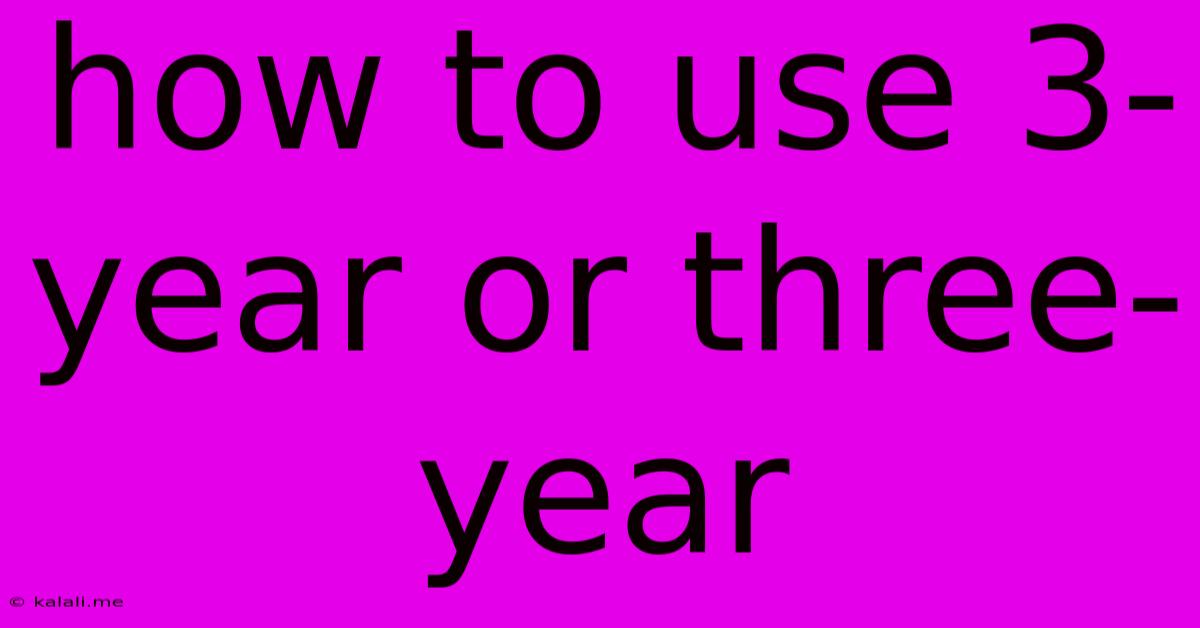How To Use 3-year Or Three-year
Kalali
May 30, 2025 · 3 min read

Table of Contents
How to Use "3-Year" or "Three-Year" in Your Writing
The phrases "3-year" and "three-year" are commonly used to describe something lasting or spanning three years. While both convey the same basic meaning, there are subtle differences in their usage and preferred contexts. This guide will help you understand when to use each and ensure your writing is clear and professional.
Meta Description: Learn the proper usage of "3-year" versus "three-year" in your writing. This guide clarifies the nuances of these phrases, ensuring your writing is clear, professional, and grammatically correct.
Understanding the Difference: Numbers and Words
The core difference lies in style: "3-year" uses numerals, while "three-year" uses words. This distinction relates to style guides and the overall tone of your writing.
-
3-year: This is generally preferred in more technical or formal writing, such as reports, scientific papers, or data-heavy documents. It's concise and avoids ambiguity in contexts where numbers are prevalent. Think of it as the more formal option.
-
three-year: This is often favored in less formal writing, such as blog posts, articles, or general-purpose documents. It enhances readability and creates a less jarring effect when surrounded by more descriptive text. Consider this the more casual option.
Examples of Proper Usage
Here are some examples showcasing the appropriate use of each phrase in various contexts:
Using "3-year":
- "3-year plan": Suitable for a business document outlining a strategic plan.
- "3-year warranty": Common in product specifications or legal documents.
- "3-year old child": Standard phrasing in many situations, though "three-year-old" is also acceptable. The hyphenation is key here.
- "A 3-year study showed...": Ideal in academic papers or reports presenting research findings.
Using "three-year":
- "a three-year-old child": Preferred over "a 3-year-old child" in many informal settings. Note the hyphenation which is essential.
- "a three-year commitment": Suitable for a personal essay or informal letter.
- "The company implemented a three-year marketing strategy.": Appropriate in a business blog post or informal report.
- "He completed a three-year apprenticeship.": Fits well in general narrative writing.
Hyphenation: A Crucial Aspect
Both "3-year" and "three-year" are often followed by a noun. When this occurs, the phrase generally functions as a single adjective modifying that noun. Hyphenation is crucial in such cases. It prevents misinterpretations and maintains grammatical accuracy. For example:
- Correct: a 3-year-old child, a three-year plan, a three-year study
- Incorrect: a 3 year old child, a three year plan, a three year study
Consistency is Key
Regardless of whether you choose "3-year" or "three-year," maintain consistency throughout your document. Switching between the two within the same piece of writing can appear jarring and unprofessional. Select a style and stick with it.
Conclusion
The choice between "3-year" and "three-year" depends on the context and your desired tone. Consider the formality of your writing, the surrounding text, and the overall style guide you're following. Remember the importance of hyphenation when these phrases function as adjectives. By adhering to these guidelines, you can ensure your writing is both clear and grammatically correct.
Latest Posts
Latest Posts
-
Keyless Entry Keypad With Different Pin Numbers
Jun 01, 2025
-
How To Change Back From Text Message To Imessage
Jun 01, 2025
-
How To Wire Outlet Switch Combo
Jun 01, 2025
-
Dnd Is 5 Feet Away Mean Touching
Jun 01, 2025
-
Weird Symbole Genertaed By Password Generator
Jun 01, 2025
Related Post
Thank you for visiting our website which covers about How To Use 3-year Or Three-year . We hope the information provided has been useful to you. Feel free to contact us if you have any questions or need further assistance. See you next time and don't miss to bookmark.